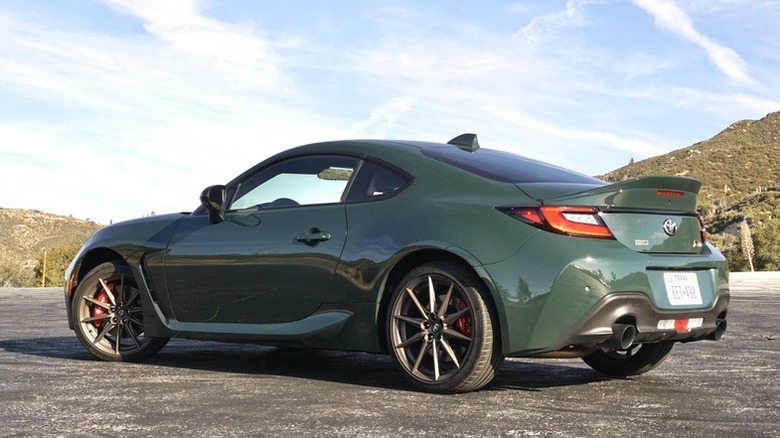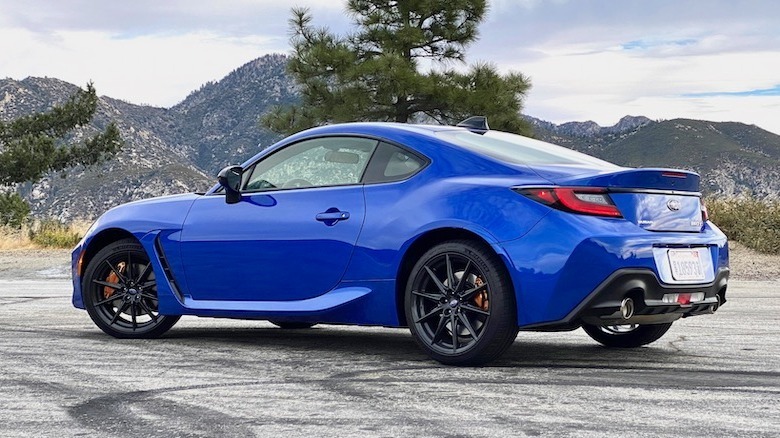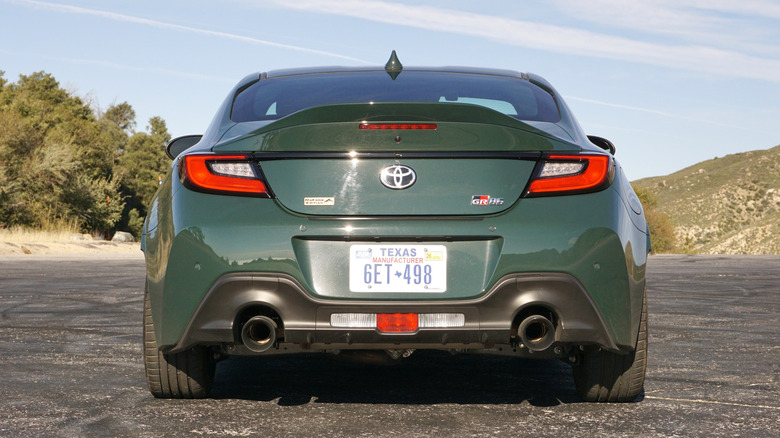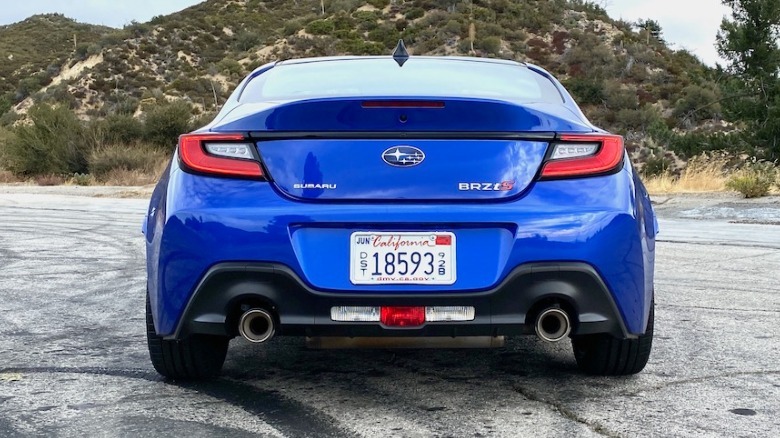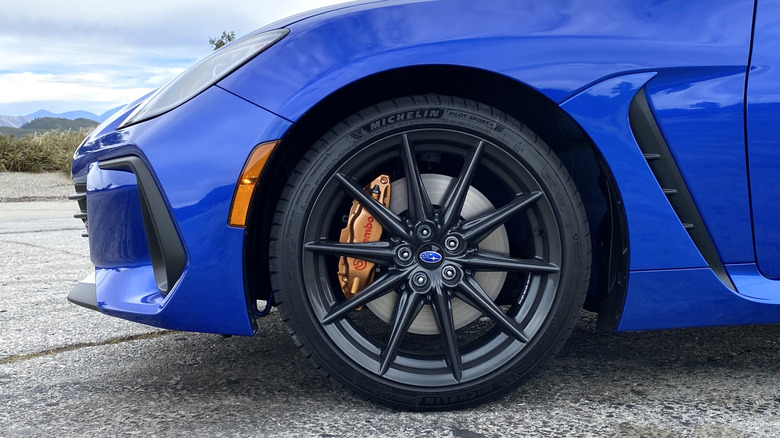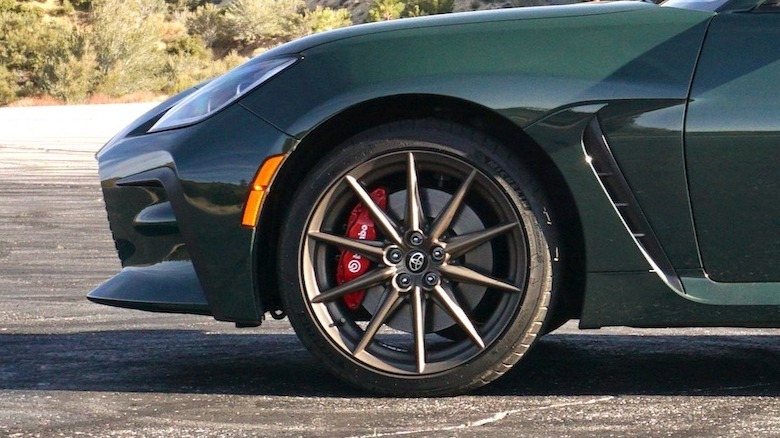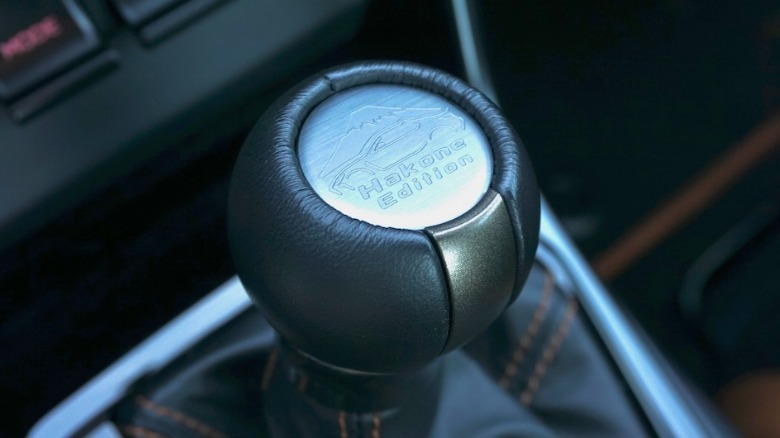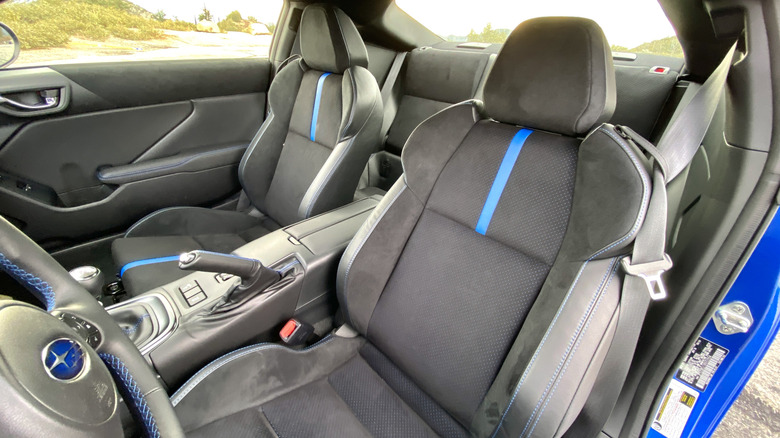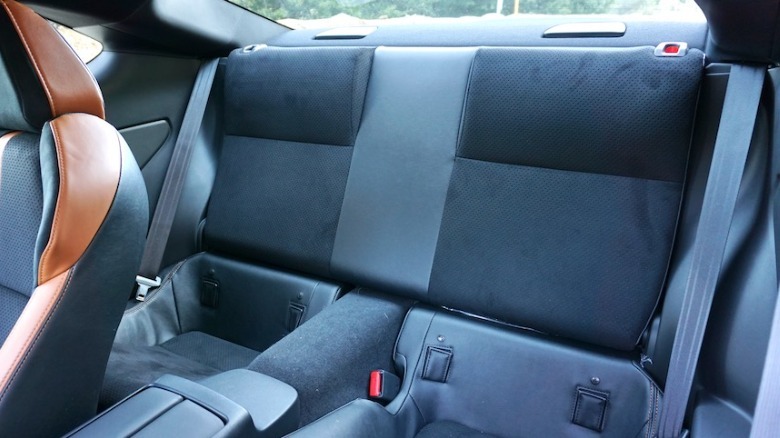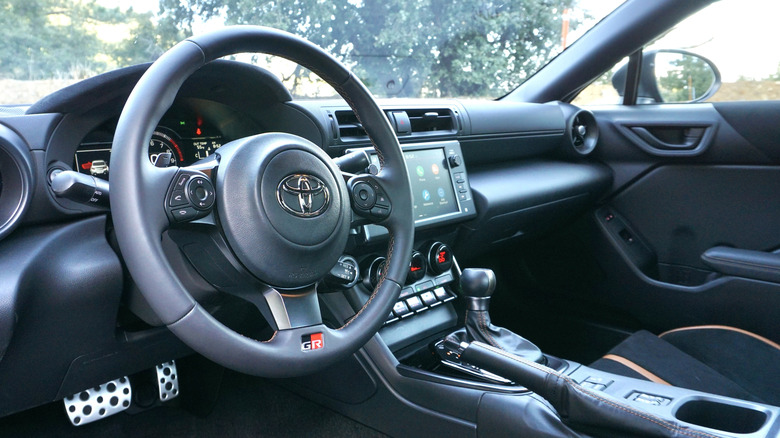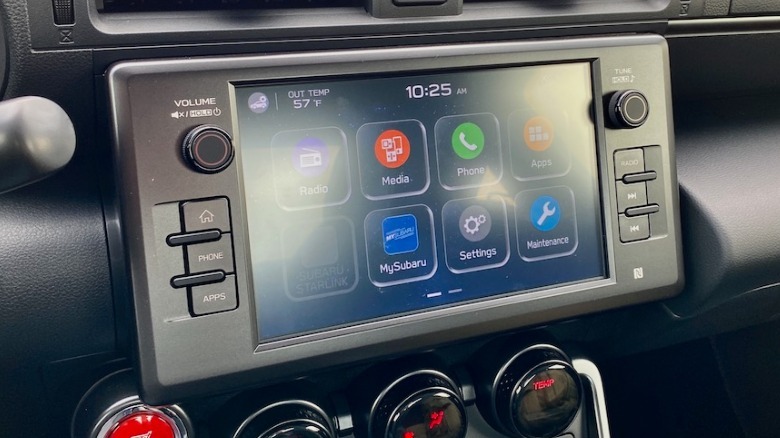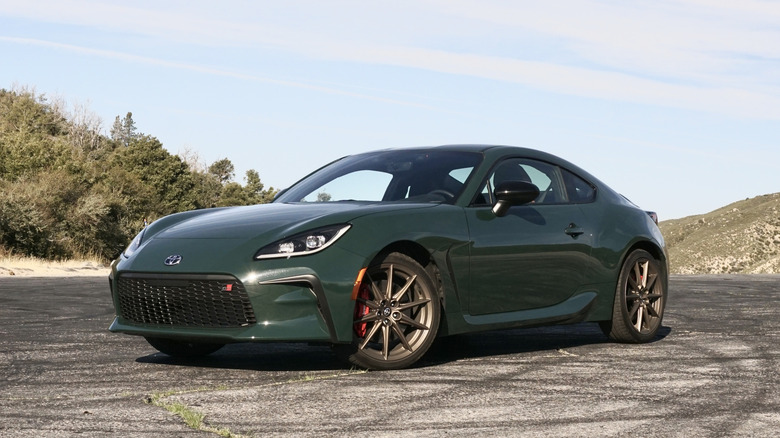2025 Subaru BRZ tS Vs Toyota GR86: What's The Real Difference, And Should You Pay Extra?
To the casual observer, and perhaps even to some relatively-seasoned enthusiasts, the Subaru BRZ and the Toyota GR86 are basically the same car. They have different badges, but they're both built on the same assembly line at Subaru's factory in Gunma, Japan. They use the same engine and offer the same transmissions. Both on the surface and beneath it, they're nearly identical. They use many of the same body panels, the same seats, the same tech, and spotting the differences on the inside will take one seriously eagle-eyed investigator. If you're interested in one or both vehicles though, that might leave you questioning whether or not there's any differences at all.
To find out if one stood out compared to the other, I drove both the GR86 and the BRZ. I put plenty of miles on both coupes in the city, on the highway, and in the local canyons to evaluate things like comfort and performance. And, to cap it all off, I took a deep dive into the spec sheets, pricing out both models at the top and bottom of their respective ranges, and I came out the other side with a definitive answer as to which one I prefer.
Pricing them out
To kick things off, let's look at the price range that each model offers. The 2025 GR86 has three main trim levels: base, Premium, and Hakone Edition. The base model has a low starting price of just $31,135 (including $1,135 destination fee). The mid-level Premium trim has an MSRP of $33,735 and if you add an automatic transmission, that ups the price by $1,100.
A $1,500 Performance package is available which adds Brembo brakes and SACHS suspension dampers. The Hakone Edition includes the Performance package equipment and it has an MSRP of $36,405.
Like its sibling, the 2025 BRZ comes in three different trim levels: Premium, Limited, and tS. The Premium has a starting price of $32,380 (including $1,170 destination fee). The manual-transmission Limited trim bumps that up to $35,030 and the automatic is $35,880. The tS trim (also known as tuned-by-STI) has an MSRP of $37,530.
There aren't any options packages available, but it does come standard with the Brembo brakes offered as optional on the GR86 and you can get some dealer-installed accessories if you want – stuff like an STI shift knob, a unique spoiler, a rear diffuser, and interior footwell lighting. A fourth version of the BRZ called the Series.Purple is also available, which starts at $35,560 (not including destination), but it's being sold in limited production numbers. Advantage: Toyota.
Are there any performance differences?
So, the Toyota costs a bit less than the Subaru, pretty much across the range: somewhere around $1,000 when you compare the two vehicle's similar trim levels. Considering the price difference, though, these two are strikingly similar in terms of equipment and performance. Both the GR86 and the BRZ use a 2.4-liter four-cylinder boxer engine, producing 228 horsepower and 184 lb-ft of torque in both cars. paired with either a six-speed manual transmission or a six-speed automatic. So, there's no difference there.
Curb weight for the GR86 falls between 2,811 and 2,868 pounds. Those are scant numbers for any modern car and they ever-so-slightly beat out the BRZ. The BRZ has a quoted curb weight that ranges between 2,820 and 2,881 pounds. In terms of driving characteristics, the difference in weight is completely imperceptible.
Braking was strong and responsive, even after long days spent driving in the canyons. There are some subtle differences in the way these two coupes drove based on their suspension setups, though. The differences in spring rates and anti-roll bars lead the BRZ to be slightly more adept at taking corners. It's a small margin that separates the two, however, so I wouldn't say that the GR86 is any less desirable – it's still an excellent driver's car.
More real-world driving impressions
Between the two cars, the BRZ (especially in the tS trim with the STI-tuned suspension) is the stiffer option. The GR86 had a firm ride too, but it was slightly smoother and it felt a bit more forgiving on harsh city streets. It's worth noting that the differences I sensed between these two were infinitesimal. I took copious notes when driving these two cars, comparing them over the same stretches of highway and mountain roads, but there wasn't much to separate them in the long run.
The BRZ tS I tested came with a manual transmission, while the GR86 was equipped with an automatic, which clearly changed the driving experience. The BRZ felt more engaging based on the transmission alone, but both cars are available with either a manual or an automatic, so that wasn't really a differentiator worth considering in the final verdict. Testing the automatic transmission, however, did give me even more reason to like these coupes.
The six-speed manual in the BRZ was excellent, with smooth shifts and a pleasantly short shifter; that wasn't really a shocker. The surprise came via the automatic in the GR86, which was much more than serviceable when it came to enthusiastic driving than I would've expected. The paddle shifters gave a nice click (even if shifts did take a moment to catch up to the request) and having an automatic made dealing with the doldrums of daily commuting much more manageable.
Ride quality and space for your stuff
Both the BRZ and the GR86 are comfortable enough for long road trips or daily driving, even if they aren't grand-tourers. The cars both came equipped with Michelin Pilot Sport 4 tires, which were plenty grippy, but they didn't absorb much in the way of road imperfections. Small impacts make their way into the cabin and broken roads can feel pretty harsh, but it's mostly just mild discomfort.
When you consider their low starting prices, there's a lot of value in the driver comfort they do provide. The front seats were comfortable, well-bolstered, and they held me in place well when I was darting between apexes. The seat heaters were strong enough to get me nice and toasty when the weather was on the chilly side.
The back seats, by contrast, were laughably small. Virtually no human who has grown out of a baby seat will sit comfortably in the back of these cars. Instead of thinking about the back seat as a viable option for transporting passengers, it's best to regard it as a large storage area or an extension of the trunk. Cargo space, after all, is pretty limited in both: just 6.3 cubic feet of space in the trunk. Visibility is strong, however, with large windows and relatively small blind spots, especially when you consider the cars' overall diminutive size.
Nobody's perfect
It's not all sunshine and rainbows for the BRZ and the GR86. Both cars had a significant amount of road noise during my tests. At highway speeds, the tires made very audible humming noises that were hard to drown out with the underwhelming stereos. The GR86's louder optional exhaust made the road-noise situation a bit worse for Toyota, but since it was an optional extra equipped to my test car, I gave it a bit of grace.
Both cars come standard with a six-speaker stereo but both of my test vehicles were equipped with the optional eight-speaker stereos. Unfortunately, even the upgraded stereos were underpowered (they didn't get loud enough) and provided poor audio quality. If I owned either car, my first likely modification would be an overhaul of the audio system.
In a particularly telling moment during my test of the two vehicles, my uninterested-in-most-cars girlfriend commented on the GR86's interior saying, "it's old school in here". She could've been talking about either one of them, and she wasn't wrong. Both the BRZ and GR86 have bare-bones interiors, even on these top trim levels. The climate control knobs, the dashboard buttons and switches, even two-position switches for the heated seats felt like they had been sourced from the original BRZ and FR-S that debuted back in 2013. Thankfully, the number of buttons you can press inside the cabin is limited – both cars have clean dashboards without the distraction of exorbitant controls.
Color inside the lines
If style is a top concern for you, available colors might help sway your decision. For the standard and Premium GR86 there are six exterior colors to choose from: Raven, Pavement, Steel, Trueno Blue, Halo, and Track bRED. Halo and Track bRED are both an extra $475 – a very reasonable price for a paint color upgrade. The Hakone Edition model is available in just one color: Ridge Green. It's probably tied for my favorite color, right up against the Trueno Blue – especially because Ridge Green looks so damn good with those Bronze wheels.
The BRZ is available in a similar array of colors (no surprise there): WR Blue, Crystal Black, Magnetite Gray, Ignition Red, Ice Silver, Crystal White, and Sapphire Blue. Essentially, Subaru's color-naming-scheme is a bit fancier, but the color choices between these two are the same. There are, of course, exceptions like the Ridge Green Hakone edition and the upcoming Yuzu yellow GR86. The BRZ is also offered in a limited Series.Purple trim level that has a new Galaxy Purple paint scheme – limited to just 500 models.
The Verdict: BRZ or GR86?
Given the decision between the Subaru and the Toyota, I'd go with the Toyota. I like the front grille a bit better, the pricing is more attractive, and the Hakone Edition has an epic color combo. The GR86 has a few accessories that are particularly appealing to me, and even though I wouldn't pick the specific exhaust that was on my test vehicle, it's nice to have as an option. If you like the Subaru's style, then the small difference in price shouldn't be too tall of a hurdle to overcome.
Whichever nameplate you decide to go with, here's my plea to Subaru and Toyota: resist the urge to make the GR86 or the BRZ any "better." Keep them exactly the way they are. Update them minimally if you must, but leave them exactly the same for as long as you can.
Limited features, a simple color palette, basic interior amenities, and a focus on driving fun are all part of the equation that make these affordable sports cars great. Adding a long list of high-tech features, big power under the hood, or a something silly like a dual-clutch transmission would certainly lead to price increases, and that's the opposite of the successful ethos behind these two.

